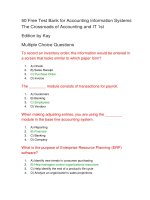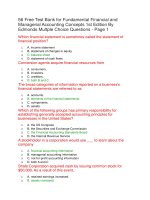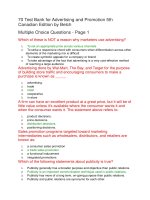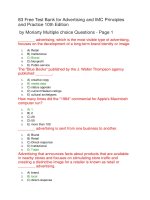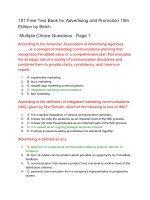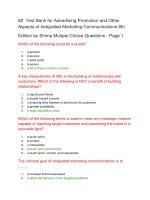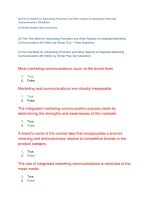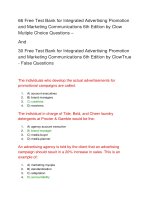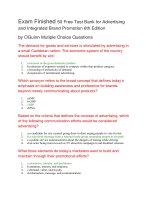60 free test bank for advertising promotion and other aspects of integrated marketing communications 9th edition
Bạn đang xem bản rút gọn của tài liệu. Xem và tải ngay bản đầy đủ của tài liệu tại đây (160.82 KB, 25 trang )
60 Free Test Bank for Advertising Promotion and Other Aspects of Integrated Marketing
Communications 9th Edition
by Shmip Mutiple Choice Questions
35 Free Test Bank for Advertising Promotion and Other Aspects of Integrated Marketing
Communications 9th Edition by Shmip True – False Questions
6 Free Test Bank for Advertising Promotion and Other Aspects of Integrated Marketing
Communications 9th Edition by Shmip Free Text Questions
Most marketing communications occur at the brand level.
1.
2.
True
False
Marketing and communications are virtually inseparable.
1.
2.
True
False
The integrated marketing communication process starts by
determining the strengths and weaknesses of the marketer.
1.
2.
True
False
A brand’s name is the central idea that encapsulates a brand’s
meaning and distinctiveness relative to competitive brands in the
product category.
1.
2.
True
False
The use of integrated marketing communications is restricted to the
mass media.
1.
2.
True
False
The ultimate objective of successful marketing communications is to
cut costs.
1.
2.
True
False
One reason firms have not practiced IMC is because different units
within organizations have specialized in separate aspects of
marketing communications.
1.
2.
True
False
Coordination of messages and media is absolutely critical to
achieving a strong and unified brand image and moving consumers
to action.
1.
2.
True
False
By closely integrating multiple communication tools and media,
brand managers achieve duplicity, which means multiple methods
in combination with one another yield more positive communication
results than do the tools used individually.
1.
2.
True
False
The terms touch point and contact are used interchangeably to
mean any message medium capable of reaching target customers
and presenting the brand in a favorable light.
1.
2.
True
False
A brand has no equity if consumers are unfamiliar with it.
1.
2.
True
False
The concept of media is relevant to all marcom tools.
1.
2.
True
False
In reality, IMC is little more than a management fad that is short
lived.
1.
2.
True
False
The use of marketing communications is not appropriate for
organizations delivering not-for-profit services.
1.
2.
True
False
The various types of brand-level marcom decisions include
fundamental decisions and implementation decisions.
1.
2.
True
False
There is an optimum mixture of expenditures between advertising
and promotion that can be determined using computer models.
1.
2.
True
False
The IMC approach uses the “inside-out” approach in identifying
communication vehicles.
1.
2.
True
False
The mixture of communications elements and the determination of
messages, media, and momentum are all fundamental decisions in
the brand-level marcom decision process.
1.
2.
True
False
Many companies treat the various communication elements, such
as advertising, sales promotions, public relations, and so on, as
virtually separate activities rather than integrated tools that work
together to achieve a common goal.
1.
2.
True
False
Novice managers are more likely than experienced managers to
practice IMC.
1.
2.
True
False
A positioning statement is the key idea that encapsulates what a
brand is intended to stand for in its target market’s mind.
1.
2.
True
False
Marketing communications play an important role for all
companies.
1.
2.
True
False
Interactive marketing communications, or simply IMC, is the
philosophy and practice of carefully coordinating a brand’s sundry
marketing communications elements.
1.
2.
True
False
Successful marketing communication requires building relationships
between brands and their consumers/customers.
1.
2.
True
False
Selection of target segments is a critical step toward effective and
efficient marketing communications.
1.
2.
True
False
One thing that has not changed in marketing communication
practices is the dependence on mass media advertising.
1.
2.
True
False
The objective of marketing communications is to enhance brand
equity as a means of moving customers to favorable action toward
the brand.
1.
2.
True
False
Purchase intentions are not valid communication measures.
1.
2.
True
False
The fundament decisions in the marcom decision process are
conceptual and strategic, and the implementation decisions are
practical and tactical.
1.
2.
True
False
The term brand is a convenient (and appropriate) label for
describing any object of concerted marketing efforts.
1.
2.
True
False
One reason firms have not practiced IMC is because outside
suppliers, such as advertising, public relations, and promotion
agencies, have been reluctant to broaden their function beyond the
one aspect of marketing communications in which they have
developed expertise and built their reputations.
1.
2.
True
False
According to a recent study, integrated marketing communications
is seldom employed by business-to-business marketers.
1.
2.
True
False
Systematic decision making requires that message content be
dictated primarily by the media vehicle used to reach the target
audience.
1.
2.
True
False
The marketing communications component of the marketing mix
has decreased dramatically in importance in recent decades.
1.
2.
True
False
Brands perform a critical strategic role by providing a key means for
differentiating one company’s offering from competitive brands.
1.
2.
True
False
6 Free Test Bank for Advertising Promotion and
Other Aspects of Integrated Marketing
Communications 9th Edition by Shmip Free Text
Questions
Compare and contrast the terms promotion and marketing
communications, and list the primary tools of marketing
communications.
Answer Given
The “4P” characterization of marketing has led to widespread use of the term
promotion for describing communications with prospects and customers. However,
the term marketing communications is preferred by most marketing practitioners as
well as many educators and is the term used to refer to the collection of advertising,
sales promotion, public relations, event marketing, and other communication
devices; comparatively, the text uses the term promotions as a shorthand reference
to sales promotions. The primary tools of marketing communications include media
advertising (e.g., TV, radio, magazines, newspapers), direct response and interactive
advertising (e.g., direct mail, telephone solicitation, online advertising), place
advertising (e.g., billboards and bulletins, posters, transit ads, cinema ads), store
signage and point-of-purchase advertising (e.g., external store signs, in-store shelf
signs, shopping cart ads, in-store radio and TV), trade- and consumer-oriented
promotions (e.g., trade deals and buying allowances, display and advertising
allowances, trade shows, cooperative advertising, samples, coupons, premiums,
refunds/rebates, contests/sweepstakes, promotional games, bonus packs, price-off
deals), and event marketing and sponsorships (e.g., sponsorship of sporting events,
arts, fairs, festivals, and causes).
Discuss the changes in marketing communication practices that
have been particularly prominent.
Answer Given
1. Reduced dependence on mass media advertising. Many brand managers and
their agencies have reduced the role of TV advertising, partially due to the fact that it
is not as effective or cost efficient as it once was due to audience fragmentation and
the availability of many alternative entertainment options. Moreover, other advertising
and non-advertising communication tools often are superior to TV in achieving brand
managers’ objectives; 2. Increased reliance on highly targeted communication
methods. Pinpointed communications are often less expensive and more effective
than mass media advertising. Targeting messages is especially feasible today with
the large, up-to-date databases of customers that are maintained by many
organizations; 3. Heightened demands on suppliers. Now it is increasingly important
for suppliers to offer multiple services, which explains why some major advertising
agencies have expanded their offerings beyond just advertising services to include
sales promotion assistance, public relations, direct marketing, and event marketing
support; 4. Increased efforts to assess communications’ return on investment.
Systematic efforts are demanded to determine whether communication programs
yield a reasonable return on their investment. The investment in marketing
communications must be assessed in terms of the profit-to-investment ratio to
determine whether changes are needed or whether other forms of investment might
be more profitable.
Describe the basic philosophy underlying integrated marketing
communications (IMC), and discuss reasons why firms have
not practiced IMC all along and why there is a reluctance to
change.
Answer Given
The philosophy underlying IMC is the careful coordination of a brand’s sundry
marketing communications elements. The reasons firms have not practiced IMC all
along include: (1) organizations have handled advertising, sales promotions, pointof-purchase displays, and other communication tools as virtually separate practices
because different units within organizations have specialized in separate aspects of
marketing communications and (2) outside suppliers (i.e., advertising agencies, PR
agencies, and sales promotion agencies) also have tended to specialize in single
facets of marketing communications rather than possess expertise across the board.
There has been a reluctance to change from this single-function, specialist model
due to managerial parochialism (e.g., advertising people sometimes view the world
exclusively from an advertising perspective and are blind to other communication
traditions) and for fear that change might lead to budget cutbacks in their areas of
control and reductions in their authority and power. Agencies also have resisted
change due to reluctance to broaden their function beyond the one aspect of
marketing communications in which they have developed expertise and built their
reputations.
Debra is the brand manager for Tide laundry detergent, marketed
by Procter & Gamble, and she is making the brand-level
fundamental decisions in the marcom decision process.
Discuss what she will be considering.
Answer Given
The fundamental decisions in the brand-level marcom decision process include: 1.
Targeting. Targeting allows marketing communicators to deliver messages more
precisely and to prevent wasted coverage to people falling outside the intended
audience. Selection of target segments is a critical step toward effective and efficient
marketing communications. Companies identify potential target markets in terms of
demographic characteristics, lifestyles, product usage patterns, and geographic
considerations. Meaningful market segments generally represent consumers who
share a combination of characteristics and demonstrate similar behavior; 2.
Positioning. A brand’s position represents the key feature, benefit, or image that it
stands for in the target audience’s collective mind. Debra must decide on Tide’s
positioning statement, which is the central idea that encapsulates the brand’s
meaning and distinctiveness vis-a-vis competitive brands in the laundry detergent
category; 3. Setting Objectives. Marketing communicators’ decisions are grounded in
the underlying goals, or objectives, to be accomplished for a brand; 4. Budgeting.
Financial resources are budgeted to specific marcom elements to accomplish
desired objectives. Different budgeting methods include top-down budgeting (TD),
bottom-up budgeting (BU), or a combination of the two (BUTD or TDBU).
Explain what the payoff is from using integrated marketing
communications.
Answer Given
The payoff is that by closely integrating multiple communications tools and media,
brand managers achieve synergy. That is, multiple methods in combination with one
another yield more positive communication results than do the tools used
individually.
Explain the five key features that undergird the philosophy and
practice of integrated marketing communications.
Answer Given
The five key IMC features are: 1. The customer represents the starting point for all
marketing communications activities. The IMC approach avoids an “inside-out”
approach (from company to customer) in identifying communication vehicles and
instead starts with the customer (“outside-in”) to determine those communication
methods that will best serve the customers’ information needs and motivate them to
purchase the brand. The point of this feature is that brand managers and their
agencies should not restrict themselves to only one set of communication media; 2.
Brand managers and their agencies should be amenable to using various marketing
communication tools. That is, carefully select those tools that are most appropriate
for the communications objective at hand. Practitioners of IMC need to be receptive
to using all forms of touch points, or contacts, as potential message delivery
channels. The key feature of this IMC element is that it reflects a willingness on the
part of brand communicators to use any communication outlets that are appropriate
for reaching the target audience; 3. Multiple messages must speak with a single
voice. Inherent in the philosophy and practice of IMC is the demand that a brand’s
assorted communication elements must all strive to present the same message and
convey that message consistently across diverse message channels, or points of
contact. Coordination of messages and media is absolutely critical to achieving a
strong and unified brand image and moving consumers to action. In general, the
single-voice principle involves selecting a specific positioning statement for a brand;
4. Build relationships rather than engage in flings. A relationship is an enduring link
between a brand and its customers. Successful relationships between customers
and brands lead to repeat purchasing and perhaps even loyalty toward a brand. One
way to build brand/customer relationships is the use of frequency, loyalty, or
ambassador programs. Relationships also are nurtured by creating brand
experiences that make positive and lasting impressions, such as special events; 5.
Don’t lose focus of the ultimate objective: affect behavior! Marketing communications
must do more than just influence brand awareness or enhance consumer attitudes
toward the brand. The objective, in other words, is to move people to action.
60 Free Test Bank for Advertising Promotion and
Other Aspects of Integrated Marketing
Communications 9th Edition by Shmip Mutiple
Choice Questions - Page 1
A key characteristic of IMC is the building of relationships with
customers. Which of the following is NOT a benefit of
building relationships?
1.
2.
3.
4.
5.
a.repeat purchases
b.loyalty toward a brand
c.enduring links between a brand and its customers
d.greater profitability
e.huge acquisition costs
Which approach will best serve the customers’ information needs
and motivate them to purchase the brand?
1.
2.
3.
4.
5.
a.inside-out
b.outside-in
c.top-down
d.bottom-up
e.combination
The idea that “context matters,” and that not all touch points are
equally effective, has been termed _____ by marcom
practitioners.
1.
2.
3.
4.
5.
a.synergy
b.media mix
c.awareness generation
d.engagement
e.contact
The context (or medium used) influences the _____ that the
message has.
1.
2.
3.
4.
5.
a.impact
b.reach
c.frequency
d.integration
e.touch points
The ultimate goal of integrated marketing communications is to
_____.
1.
2.
3.
4.
5.
a.increase brand awareness
b.affect the behavior of the targeted audience
c.learn how to outsell the competition
d.lower production costs
e.All of these are correct.
What does the phrase, “speak with a single voice,” mean?
1.
2.
3.
4.
5.
a.Carefully select those tools that are most appropriate for the communications
objective at hand.
b.Reach the target audience efficiently and effectively using whatever touch points
are most appropriate.
c.Successful marketing communications requires building relationships between
brands and their consumers/customers.
d.All marketing communication elements should use the same endorser so that
consumers do not get confused.
e.Coordination of messages and media is absolutely critical to achieving a strong and
unified brand image and moving consumers to action.
Which of the following terms serves as a summary means for
describing all forms of marketing focus?
1.
2.
3.
4.
5.
a.product
b.brand
c.communication
d.promotion
e.integration
Which of the following encapsulates what a brand is intended to
stand for in its target market’s mind and then consistently
delivers the same idea across all media channels?
1.
2.
3.
4.
5.
a.positioning statement
b.contact point
c.relationship statement
d.creative brief
e.creative platform
Which term is preferred by most marketing practitioners to refer to
the collection of advertising, sales promotions, public
relations, event marketing, and other communication
devices?
1.
a.marketing promotion
2.
3.
4.
5.
b.promotion
c.sales promotion
d.marketing communications
e.integrated marketing communications
Karen is attempting to put into words the key idea that encapsulates
what her company’s brand is intended to stand for in its
target market’s mind. Karen is writing a _____.
1.
2.
3.
4.
5.
a.relationship statement
b.creative brief
c.positioning statement
d.contact brief
e.touch point
Today, consumers are not only passive receivers of marcom
messages, but are often active participants in the marcom
process due to _____.
1.
2.
3.
4.
5.
a.economic advances
b.technological developments
c.increases in the use of sales promotion
d.changes in demographics
e.expansion of advertising agency services
Which of the following is NOT a key feature of IMC?
1.
2.
3.
4.
5.
a.The customer represents the starting point for all marketing communications
activities.
b.Brand managers and their agencies should be amenable to using various
marketing communication tools.
c.Multiple messages must speak with a single voice.
d.The ultimate goal is to influence brand awareness and enhance consumer attitudes
toward the brand.
e.Build relationships.
Which of the following terms is used to mean any message medium
capable of reaching target customers and presenting the
brand in a favorable light?
1.
2.
3.
4.
5.
a.touch point
b.contact
c.intersection
d.touch point and contact
e.touch point, contact, and intersection
Frequency, loyalty, or ambassador programs and creating brand
experiences that make positive and lasting impressions are
ways to _____.
1.
2.
3.
4.
a.speak with one voice
b.create synergy
c.build customer/brand relationships
d.start with the customer/prospect
5.
e.reach consumers who cannot be reached through traditional mass media
The marketing mix for a brand consists of _____.
1.
2.
3.
4.
5.
a.product
b.price
c.promotion
d.place
e.All of these are correct.
Brand managers should turn to alternative means of marcom as the
option of first choice rather than automatically defaulting to
_____.
1.
2.
3.
4.
5.
a.sales promotion
b.personal selling
c.point-of-purchase advertising
d.event marketing
e.mass media advertising
Which of the following has NOT been a reason for the reluctance to
change from a single-function, specialist model to an IMC
model?
1.
2.
3.
4.
a.no way to assess the effectiveness of integration
b.managerial parochialism
c.fear that change might lead to possible budget cutbacks in their areas of control
d.reluctance of agencies to broaden their function beyond the one aspect of
marketing communications in which they have developed expertise and built their
reputations
5. e.fear of reduction in authority and power
Which of the following is NOT a form of media advertising?
1.
2.
3.
4.
5.
a.television
b.radio
c.magazines
d.sales promotions
e.newspapers
The fact that it costs five to 10 times more to land a new customer
than to keep a current customer has been compared to a(n)
_____.
1.
2.
3.
4.
5.
a.clogged drain
b.leaky bucket
c.sand castle
d.ice sculpture
e.bee hive
Marketing communications is used by which type of organization?
1.
2.
3.
4.
a.business-to-business organizations
b.consumer marketing organizations
c.not-for-profit organizations
d.None of these are correct.
5.
e.All of these are correct.
Milo is employed by a manufacturer of consumer packaged goods
products. His job entails the planning, creation, integration,
and implementation of diverse forms of marcom, such as
advertising, sales promotion, publicity releases, events, etc.,
that are delivered over time to a brand’s targeted customers
and prospects with the ultimate goal of influencing or directly
affecting their behavior. Milo is performing _____.
1.
2.
3.
4.
5.
a.integrated marketing (IM)
b.marketing communications (marcom)
c.integrated marketing communications (IMC)
d.promotion marketing (PM)
e.integrated promotion management (IPM)
_____ is the philosophy and practice of carefully coordinating a
brand’s sundry marketing communications elements.
1.
2.
3.
4.
5.
a.Interactive marketing
b.Branding
c.Synergistic marketing communications
d.Synergistic marketing
e.Integrated marketing communications
The idea of surrounding the customer or prospect with a brand’s
marcom messages, or that a brand’s touch points should be
everywhere the target audience is, is known as _____.
1.
2.
3.
4.
5.
a.consumer-oriented marketing
b.the media-neutral approach
c.360-degree branding
d.the rotation principle
e.event marketing
Which of the following statements is true regarding the adoption of
IMC?
1.
2.
a.Novice managers are more likely than experienced managers to practice IMC.
b.Firms involved in marketing services rather than products are more likely to have
adopted IMC.
3. c.Business-to-business firms are more likely to adopt IMC than business-toconsumer firms.
4. d.Less sophisticated firms are likely adherents to IMC.
5. e.All of these are correct.
A key feature of IMC is that the process should _____.
1.
2.
3.
4.
a.use an “inside-out” approach
b.be restricted to only one or a select number of communication media
c.use the same media to reach all target audiences to improve efficiency
d.start with the customer or prospect and then work back to the brand communicator
in determining the most appropriate messages and media
5. e.utilize the same communication media over time
What is achieved when multiple methods are used in combination
with one another yielding more positive communication
results than when the tools are used individually?
1.
2.
3.
4.
5.
a.synergy
b.duplicity
c.multiplicity
d.redundancy
e.repetition
Coupons, trade shows, buying allowances, premiums, and price-off
deals are all examples of _____.
1.
2.
3.
4.
5.
a.media advertising
b.promotions
c.place advertising
d.point-of-purchase advertising
e.public relations
The marketing manager for Carver Products, Inc. asked her
research staff to identify all of the points of contact that
consumers are likely to have with Carver’s products. The
marketing manager would most likely use this information in
designing a(n) _____.
1.
2.
3.
4.
5.
a.point-of-purchase display
b.board of director’s report
c.integrated marketing communications program
d.marketing research survey
e.slice-of-life television commercial
Current marketing philosophy holds that _____ is absolutely
imperative for success.
1.
2.
3.
4.
5.
a.direct marketing
b.e-mail
c.coupons
d.integration
e.assessment
Which of the following could be a brand?
1.
2.
3.
4.
5.
a.product
b.service
c.retail outlet
d.person
e.All of these are correct.
60 Free Test Bank for Advertising Promotion and
Other Aspects of Integrated Marketing
Communications 9th Edition by Shmip Mutiple
Choice Questions - Page 2
Which of the following is an example of a communication outcome?
1.
2.
3.
4.
5.
a.increase sales to grocery stores by 10 percent
b.increase total sales by 15 percent
c.maintain existing sales levels in Japan
d.increase brand awareness by 15 percent
e.increase sales in Mexico by 15 percent
Harvey is a brand manager for a national brand of soft drinks. He is
making the implementation decisions in the marcom decision
process, and he wants a marcom tool that is most capable of
directly affecting consumer behavior. Which tool should he
use?
1.
2.
3.
4.
5.
a.advertising
b.sales promotion
c.publicity
d.events
e.point-of-purchase display
The word _____ refers to an object’s force or speed of movement.
1.
2.
3.
4.
5.
a.drive
b.push
c.momentum
d.force
e.pull
The decision regarding how to allocate resources between the
marcom elements has been described as an “ill-structured”
problem. What does this mean?
1.
2.
3.
a.There is no solution to the problem.
b.It is difficult to define the problem.
c.There is no way of determining the mathematical optimum allocation among
marcom elements.
4. d.There are solutions, but they are not acceptable.
5. e.There is no way to measure whether the solution chosen was the correct one.
Which of the following is NOT a budgeting method?
1.
2.
3.
4.
5.
a.top-down budgeting (TD)
b.bottom-up budgeting (BU)
c.top-down/bottom-up/top-down process (TDBUTD)
d.bottom-up/top-down process (BUTD)
e.top-down/bottom-up process (TDBU)
Which of the following is an implementation decision in the brandlevel marcom decision process?
1.
2.
3.
4.
5.
a.targeting
b.mixing elements
c.budgeting
d.positioning
e.setting objectives
For a given level of expenditure, there is no way of determining the
mathematical optimum allocation between advertising and
promotion because _____.
1.
2.
3.
a.advertising and promotions are somewhat interchangeable
b.advertising and promotions produce a synergistic effect
c.advertising is appropriate for early stages of the product life cycle, and promotion is
more appropriate during later stages
4. d.they are somewhat interchangeable and produce a synergistic effect
5. e.None of these are correct.
One way relationships between brands and customers are nurtured
is by creating brand experiences that make positive and
lasting impressions. This is done by creating special events
or developing exciting venues that attempt to _____.
1.
2.
3.
4.
5.
a.appeal to consumers’ demographic characteristics
b.reposition products or services by connecting with consumers’ functional needs
c.generate increased sales to current customers
d.develop new target markets
e.build the sensation that the brand is relevant to the consumer’s lifestyle
Which of the following is NOT a change in marketing
communication practices?
1.
2.
3.
4.
5.
a.increased reliance on outside suppliers, or specialized services
b.reduced dependence on mass media advertising
c.increased reliance on highly targeted communication methods
d.heightened demands on suppliers
e.increased efforts to assess communications’ return on investment
When counseling its clients in selecting appropriate marcom tools,
McCann Worldgroup uses an approach that requires that the
brand marketer first identify the goal(s) a marcom program is
designed to accomplish and then identify the best way to
allocate the marketer’s budget. What is this approach known
as?
1.
2.
3.
4.
5.
a.inside-out
b.bottom-up
c.media-neutral
d.media-centric
e.goal oriented
Allison is trying to determine how much to allocate for advertising
and how much to allocate for promotions during the next
year. Which implementation decision is Allison making?
1.
2.
3.
4.
5.
a.mixing elements
b.creating messages
c.selecting media
d.establishing momentum
e.targeting
The most frequently used budgeting method is _____.
1.
2.
3.
4.
5.
a.top-down (TD)
b.bottom-up (BU)
c.top-down/bottom-up/top-down (TDBUTD)
d.bottom-up/top-down (BUTD)
e.top-down/bottom-up (TDBU)
Fundamental decisions in the brand-level marcom decision process
are _____, and implementation decisions are _____.
1.
2.
3.
4.
5.
a.tactical; strategic
b.strategic; tactical
c.long-term; short-term
d.short-term; long-term
e.practical; conceptual
Joan Kaufman is a senior manager of a large conglomerate. She
decides how much money is allocated to each subunit. This
is an example of _____ budgeting.
1.
2.
3.
4.
5.
a.top-down
b.bottom-up
c.bottom-up/top-down
d.top-down/bottom-up
e.hierarchy
Which of the following is a fundamental decision in the brand-level
marcom decision process?
1.
2.
3.
4.
5.
a.targeting
b.positioning
c.setting objectives
d.budgeting
e.All of these are correct.
A brand’s _____ represents the key feature, benefit, or image that it
stands for in the target audience’s collective mind.
1.
2.
3.
4.
5.
a.equity
b.image
c.position
d.name
e.trademark
Which of the following variables do companies use to identify
potential target markets?
1.
2.
3.
4.
5.
a.demographic characteristics
b.lifestyles
c.product usage patterns
d.geographic considerations
e.All of these are correct.
John is a subunit manager at a large consumer packaged goods
manufacturer. Every year, he submits a budget request to the
vice president of marketing, who coordinates the various
requests and then submits an overall budget to top
management for approval. This is an example of _____
budgeting.
1.
2.
3.
4.
5.
a.top-down
b.bottom-up
c.top-down/bottom-up
d.bottom-up/top-down
e.combination
The term media applies to which marcom tool?
1.
2.
3.
4.
5.
a.advertising
b.public relations
c.promotions
d.personal selling
e.All of these are correct.
Over the past two decades, the trend has moved toward greater
expenditures on _____.
1.
2.
3.
4.
5.
a.advertising
b.public relations
c.personal selling
d.promotions
e.point-of-purchase displays
A satisfactory mixture of advertising and promotion expenditures
can be formulated by considering the different purposes of
each. A key strategic consideration is whether _____.
1.
2.
3.
a.short- or long-term goals are more important
b.the budget would allow for the relatively larger expense of advertising
c.the organization has the expertise in its current staff to develop successful
promotions
4. d.the majority of the target market is price sensitive
5. e.use of sales promotion is necessary given current economic conditions
Julie and her department are responsible for making brand-level
fundamental and implementation marcom decisions. What
are the expected outcomes of these decisions?
1.
2.
3.
4.
5.
a.increasing sales and profits
b.enhancing brand awareness and attitudes
c.enhancing brand equity and affecting behavior
d.increasing purchase intentions and affecting behavior
e.enhancing brand equity and increasing brand awareness
_____ allows marketing communicators to deliver messages more
precisely and to prevent wasted coverage to people falling
outside the intended audience.
1.
2.
3.
4.
5.
a.Targeting
b.Positioning
c.Budgeting
d.Setting objectives
e.Momentum
The objective of marketing communications is to _____ as a means
of moving customers to favorable action toward the brand.
1.
2.
3.
4.
5.
a.increase brand awareness
b.cut costs
c.increase product usage
d.enhance brand equity
e.increase the rate of purchase
All marketing communications should be _____.
1.
2.
3.
4.
5.
a.directed to a particular target market
b.clearly positioned
c.created to achieve a specific objective
d.undertaken to accomplish the objective within budget constraints
e.All of these are correct.
One important factor that has led more firms to perform research
and acquire data to determine whether implemented marcom
decisions have accomplished the objectives they were
expected to achieve is _____.
1.
2.
3.
4.
5.
a.increasing demand for accountability
b.rapidly changing consumer tastes and preferences
c.changing economic conditions
d.increasing marcom expenses
e.less reliance on outside agencies to perform the marcom function
What is the greatest obstacle to implementing integrated marketing
communications?
1.
2.
3.
a.There is a lack of interest in IMC by top management.
b.The cost for implementing an IMC program is difficult to justify.
c.Little can be gained by coordinating the various marketing communications
elements.
4. d.Few providers of marketing communication services have the far-ranging skills to
plan and execute programs that cut across all major forms of marketing
communications.
5. e.Measuring the return on investment is nearly impossible.
The ultimate objective of IMC is to _____.
1.
2.
3.
a.start with the customer or prospect
b.move people to action
c.carefully select those tools that are most appropriate for the communications
objective at hand
4. d.use as many communications outlets as possible to reach the target audience
5. e.speak with a single voice
Program evaluation is accomplished by _____.
1.
2.
3.
4.
5.
a.developing a budget that is based on marcom objectives and includes an optimum
balance of advertising and promotion
b.measuring the results of marcom efforts against the objectives that were
established
c.collecting data on consumers’ demographics and lifestyles
d.constructing a database of information on the target market, economic conditions,
and competitors’ marcom strategies
e.comparing budgeted marcom expenditures against share-of-voice
Which of the following is NOT a communications outcome
measure?
1.
2.
3.
4.
5.
a.purchase intentions
b.brand awareness
c.message comprehension
d.attitude toward the brand
e.All of these are measures of communication outcomes.

